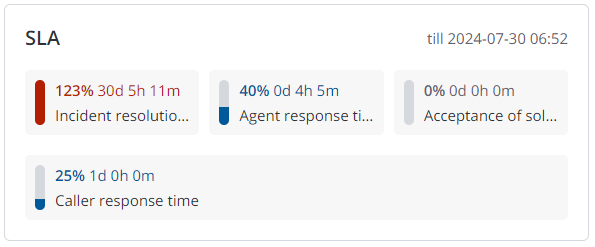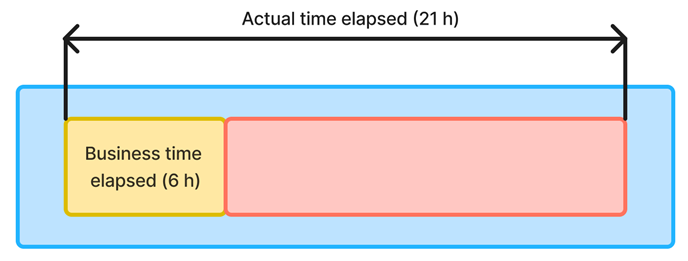Indications
Create indications
An indication is a time counter. It is automatically generated when the indicator start conditions are met. It shows time indications and the current state of the agreement for a particular record, so the users can track the level of the service quality target indicators.
The indications are displayed on the form in the SLA Indications SA widget:

Detailed information about the widget configuration is available in the SLA Indications SA article.
When an indicator record is created, it specifies the key timestamps and a link to the related record. Time indicators are automatically recalculated with the periods specified in the settings. Also, the recalculation of time indicators occurs in cases of counting pauses, cancelations, or when the indication stops.
Note that:
- For new indications (sys_indication) business rules of type before do not work.
- For new indications (sys_indication) business rules of type after work asynchronously.
- The creation of new columns for the Indication (sys_indication) and Indicator (sys_indicator) tables is prohibited.
To check the indication for a record, complete the steps below:
- Open the required record.
- In the Related Lists area, select the Timepoints Indication tab.
- Open the indication record you need to check.
To check the active indications, navigate to Indication Management → Indications.
Indication form fields
| Field | Description |
|---|---|
| Indicator | An indicator that initiated the start of the indication and started the counter. When you clear the Active checkbox or delete an indicator, the related indications are canceled. In the related indication records, the Updated at field displays the time the indication was canceled. |
| Timezone | The indication timezone. |
| Record | The original task the agreement refers to. |
| Breached | The marker that shows whether the agreement has been breached. |
| Actual time elapsed | Actual time that has elapsed since the indication started, displayed in days, hours, minutes, and seconds. It is calculated on the regular 24/7 basis. The field itself stores duration in milliseconds. |
| Actual time elapsed in % | The ratio calculated by the formula described below. |
| Actual time left | Actual time left until the agreement is breached, displayed in days, hours, minutes, and seconds. It is calculated on the regular 24/7 basis. The field itself stores duration in milliseconds. |
| Start time | The date and time when an indication started. |
| Complete time | The date and time when a time counter (an indication) stopped. |
| State | The current state of an indication specified:
|
| Pause on | The last date and time when the indication paused. |
| Pause time | The total duration of the indication pauses, displayed in days, hours, minutes, and seconds. The field itself stores duration in milliseconds. |
| Business time elapsed | Business time that has elapsed since the task was started, displayed in days, hours, minutes, and seconds. It counts the working calendar specified in the Schedule field of the original indicator. The field itself stores the duration in milliseconds. |
| Business time elapsed in % | The ratio calculated by the formula described below. |
| Business time left | Business time left until the agreement is breached, displayed in days, hours, minutes, and seconds. The calculation counts the working calendar specified in the Schedule field of the original indicator. The field itself stores the duration in milliseconds. |
| Breach time | The date and time of the agreement breach that the system calculates, taking into account the pause duration, or that is taken from the field defined in the Breach time field of the original indicator. |
| Original breach time | The original date and time of the agreement breach, calculated at the moment when the system creates an indication, or taken from the Breach time field of the original indicator. |
If you have reports based on the indications of the old SLA module, change the report settings and specify the new Indication (sys_indication) table.
Timings and percentages
The indication record contains two sets of fields containing timing information related to the task. These are:
- Actual time elapsed
- Actual time elapsed in %
- Actual time left
and
- Business time elapsed
- Business time elapsed in %
- Business time left
The difference between these values is that the "actual" values are always calculated on the 24x7 basis, while the "business" values take into account the schedule specified for the related indicator.
Example
-
Create an indicator with the following conditions:
Field Value Name Name Commitment type Resolution Time Table Task Active true Indication start time Defined by condition Indication breach time Defined by duration Duration 10 minutes Schedule 8x5 Timezone Europe/Moscow Timezone source Indicator timezone Start Conditions
Field Value Start conditions State IS In progress When to cancel Do not cancel Pause Conditions
Field Value Pause conditions State IS Postponed Completion Conditions
Field Value Completion conditions State IS Completed -
Create a task record:
- Navigate to https://{your_instance_url}/record/task.
- Fill in the mandatory fields. Move it to the In progress state.
- Click Save or Save and exit to apply the changes. An indication starts.
The Start time field of the indication is populated with the time when the indication actually started. The Original breach time field is populated with the time when the indication is to be breached. This value is calculated by summarizing the indication start time and the related indicator duration.
Next, consider a case when an indicator uses a popular schedule "8x5" (5 working days for 8 hours). Using this schedule, the difference between actual and business timings can be considerable. For example, an incident rose at 1 pm on a working day. The indication start condition is defined as "State IS In progress", and an indication complete condition is defined as "State IS Completed". So, the incident was taken to work at 2 pm (the indication started), and it was completed at 11 am on the next day (the indication completed). Thus, its business time elapsed was 6 hours, while the actual time elapsed was 21 hours.

Calculation nuances
As mentioned above, the "actual" time values are always calculated on the 24x7 basis, unlike the "business" values. These "business" fields consider the schedule specified in the indicator.
- If the specified schedule is invalid or deleted, the 24x7 schedule is used for calculations.
- A schedule is applied based on the timezone specified in the parent indicator.
In formulas below, NOW stands for the current date and time.
Used values
| Value | Formula | Description |
|---|---|---|
| Start time (ST) | - | Indication start date and time. |
| Breach time (BrT) | - | Agreement breach date and time.
|
| Pause time (PT) | - | Total duration of pauses that is calculated based on the schedule. |
| Actual duration (AD) | BrT - ST | An actual duration. It is used to calculate the actual time according to the 24x7 schedule. |
| Indicator duration (D) | - | An indicator duration. It is used in business time calculations according to the specified schedule. |
| ^SCH | - | The ^SCH means that the formula uses the specified schedule when calculating. |
The Business time elapsed and Business time left values are calculated based on the schedule specified and stored in the Duration format.
-
The Actual time elapsed (ATE) value is calculated as the difference between the current date and time and the Start time (ST) value.
ATE = NOW - ST
-
The Actual time left (ALT) value is calculated as the difference between the Breach time (BT) value and the current date and time.
ALT = BrT - NOW
After the indication is breached, the Actual time left stops calculating (that is, no more time left). Also, the Actual time elapsed and Actual time left values are stored in the Duration format.
-
The Actual time elapsed in % (ATE%) value is calculated by the formula below:
ATE% = ATE/AD 100 (%)*
-
The Business time elapsed (BET) value can be calculated using the formula below:
BET = (NOW - ST)^SCH - PT
-
The Business time left (BLT) value can be calculated using the formula below:
BLT = (BrT - NOW)^SCH
After the indication is breached, the Business time left stops calculating (that is, no more time left).
-
The Business time elapsed in % (BTE%) can be calculated using the formula below:
BTE% = BET/D * 100 (%)
The maximum value for BTE is 999% by default.
Recalculation of indications
The duration of recalculation periods is fixed and cannot be changed.
| Time before breach | Recalcultation period, minutes |
|---|---|
| More than a day | 120 |
| From 6 hours to a day | 60 |
| From 2 to 6 hours | 30 |
| From 30 minutes to 2 hours | 10 |
| Less than 30 minutes | 1 |
| Indication is breached | 120 |
The indication stops recalculation when the value of the Actual time elapsed in % field reaches 1100.